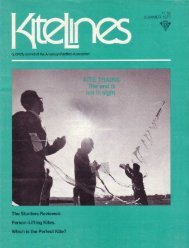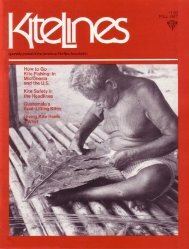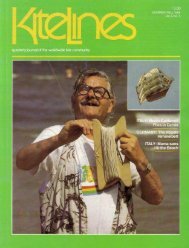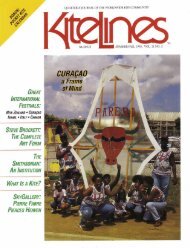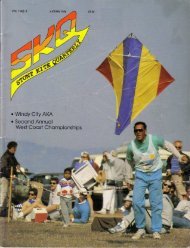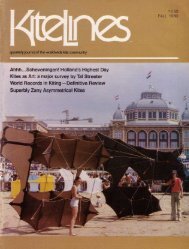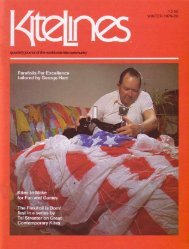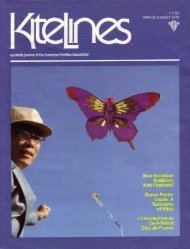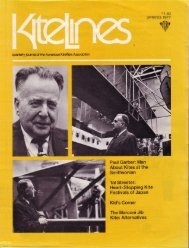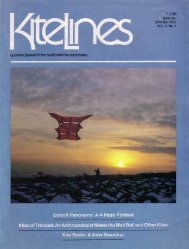Kite Lines - Vol.2 No. 4 - KiteLife
Kite Lines - Vol.2 No. 4 - KiteLife
Kite Lines - Vol.2 No. 4 - KiteLife
- No tags were found...
Create successful ePaper yourself
Turn your PDF publications into a flip-book with our unique Google optimized e-Paper software.
What's New. . .Continued from page 13ty . Bowed cross spars, as in fighter kites,add dihedral as needed . Tasseling is justenough to create necessary drag . Thecenturies-old techniques and designs ofCeylon live on, modified and improvedby the care and knowledge the craftsmancontributes from his own mind and hands .Whether or not you know all this, youbenefit from it when you fly one of thesekites. There is no question that you areflying the work of a master .THE SOARING WING IN FABRICWind Mill <strong>Kite</strong>s is now turning out a clothversion of its Soaring Wing kite . The originalmodel in Mylar® was reviewed in thisspace before, where the kite was notedfor its exceptionally high aspect ratio : sixfeet wide by only one foot deep at thewidest part of the wing . The current modelis made of rip-stop nylon stunningly sectionedand sewn . Like its predecessor, itis a bit tricky to launch and recover, butthe flight is worth the effort for a skilled,adventurous flier . Under good conditions,the Soaring Wing can fly at a high angleand its best performance will be when thewind is between 5 and 10 miles per hour .The cloth version is more permanent thanthe plastic one and is quite a good buy at$33 . It's an interesting and novel additionfor the delta* collector . Wind Mill <strong>Kite</strong>s,like many kite producers now, is addingvariety to its line and acknowledging theexcitement of kiting as a spectator sport .*The testers are divided on whether this kite isa delta . In basic structure, the design seems animprobable delta (as a bat seems an improbablemammal) .BASIC AND BELIEVABLE<strong>Kite</strong>s, <strong>Kite</strong>s, <strong>Kite</strong>s: The Ups and Downsof Making and Flying Them, by Bruce H .Mitton (Drake line : Sterling PublishingCo ., 1978), 128 pages, pap . $5 .95 .You have to like a guy who suggests asthe first step to building kites that youtake a dollar to the dime store (sorry it'sno use taking a dime anymore) and buy akite and fly it . The premise is that if youcan fly a kite you can build one . BruceMitton writes as one who can and does .What you get in his book is a practical,unpretentious recitation of kiteflying experienceand tips plus basic plans to build16 kites . Mitton's choice of materials(tissue, plastic bags, dowels, matchstickbamboo, crepe paper) is geared to thebudget kite maker . Refreshingly, almosteverything he's written comes, obviously,out of his own experience rather thanfrom "research ." Other assets of the bookare : good coverage of kite safety (includingsome very illustrative pictures), plentyof fine black-and-white photographs anda readable layout . The writing is fresh andpersonal, especially in the amusing catalogof "kite types" (the Runner, the Demolitionist,etc .), as well as the list of "reasonsto fly a kite ." Appendixes includechecklists for the kiteflier and kite builder,a bibliography and an index.Only one fault I found with the book :the bridling instructions are poor .This book adds hardly anything newto the literature . There are better booksto build by, and writers with more depthon the history and aerodynamics of kites .Occasionally, though, a book comes alongthat just breathes the author's love ofkites . I found Bruce Mitton in all thepages of his book, and I liked him .



